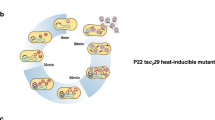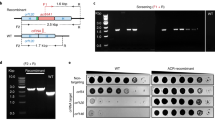Abstract
During its lytic cycle bacteriophage Mu uses repeated transposition as a mode of DNA synthesis. These transpositional events are undoubtedly replicative, and presumably semi-conservative. In a Mu lysogen this type of transposition can start immediately after prophage induction. However, in an infective cycle the Mu genome (which is injected into the host cell as a linear molecule flanked by short random sequences of bacterial DNA) must first become integrated into the host chromosome. Little is known about how this occurs apart from the fact that the bacterial sequences at either end of the Mu genome are lost in the process1. The integration is thus similar to a transposition event. In an attempt to determine whether this type of Mu transposition (between a linear donor molecule and a circular recipient) is also semi-conservative we have analysed the progeny phage arising from an infective cycle in which the parental DNA was heterozygous for a known genetic marker. The expectation is that if integration of the infecting Mu genome occurs by a single semi-conservative transpositional event then pure phage bursts should be produced as the genetic information on only one strand would be preserved throughout the lytic cycle. The experiments reported here do not support this expectation in that the infected cells yield mixed bursts, suggesting that Mu integration is a conservative, rather than a semi-conservative event.
This is a preview of subscription content, access via your institution
Access options
Subscribe to this journal
Receive 51 print issues and online access
$199.00 per year
only $3.90 per issue
Buy this article
- Purchase on Springer Link
- Instant access to full article PDF
Prices may be subject to local taxes which are calculated during checkout
Similar content being viewed by others
References
Hsu, M. T. & Davidson, N. Virology 58, 229–240. (1974).
Spatz, H. Ch. & Trautner, T. A. Molec. gen. Genet. 109, 84–106 (1970).
Wildenberg, J. & Meselson, M. Proc. natn. Acad. Sci. U.S.A. 72, 2202–2206 (1975).
Kahmann, R., Kamp, D. & Zipser, D. Molec. gen. Genet. 149, 323–328 (1976).
Maynard-Smith, S., Leach, D., Coelho, A., Carey, J. & Symonds, N. Plasmid 4, 34–50 (1980).
Coelho, A., Leach, D., Maymard-Smith, S. & Symonds, N. Cold Spring Harb. Symp. quant. Biol. 45, 323–328 (1981).
Liebart, J. C., Ghelardini, P. & Paolozzi, L. Proc. natn. Acad. Sci. U.S.A. 79, 4362–4366 (1982).
Van de Putte, P., Westmaas, G. C. & Wijffelman, C. Virology 81, 152–159 (1977).
Author information
Authors and Affiliations
Rights and permissions
About this article
Cite this article
Akroyd, J., Symonds, N. Evidence for a conservative pathway of transposition of bacteriophage Mu. Nature 303, 84–86 (1983). https://doi.org/10.1038/303084a0
Received:
Accepted:
Issue Date:
DOI: https://doi.org/10.1038/303084a0
This article is cited by
-
Application of the bacteriophage Mu-driven system for the integration/amplification of target genes in the chromosomes of engineered Gram-negative bacteria—mini review
Applied Microbiology and Biotechnology (2011)
-
Regulation of bacteriophage Mu transposition
Genetica (1994)
-
The Mugem operon: Its role in gene expression, recombination and cell cycle
Genetica (1994)
-
Phage Mu transposase: deletion of the carboxy-terminal end does not abolish DNA-binding activity
Molecular and General Genetics MGG (1987)
-
Transposition of Tn554 does not generate a target duplication
Nature (1984)
Comments
By submitting a comment you agree to abide by our Terms and Community Guidelines. If you find something abusive or that does not comply with our terms or guidelines please flag it as inappropriate.



